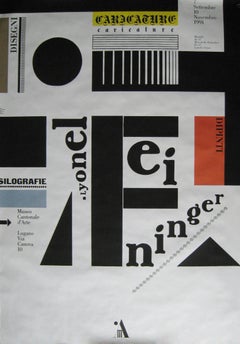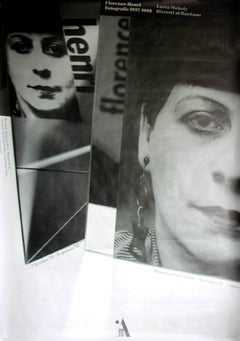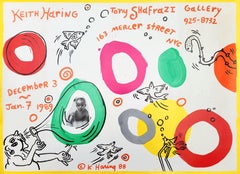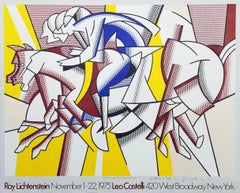Bruno Monzuzzi Prints and Multiples
to
2
Overall Width
to
Overall Height
to
1
2
1,183
938
886
817
2
1
1
1
1
1
1
1
1
1
1
1
1
2
Artist: Bruno Monzuzzi
Oskar Schlemmer/Igor Stravinsky's "Les Noces"
By Bruno Monzuzzi
Located in New York, NY
Oskar Schlemmer/Igor Stravinsky's Les Noces, 1988. Color
Lithograph. 35.5 x 50 inches (90 x 127 cm)
Monguzzi studied in Geneva and London, spent part of his early career in at the studio of Antonio Boggeri, in Milan. The inspiration of the experimental and visually-daring work of the avant garde designers Herbert Bayer, El Lissitsky, Jan Tschichold, Piet Zwart, Paul Schuitema, Ladislav Sutnar...
Category
1980s Abstract Bruno Monzuzzi Prints and Multiples
Materials
Lithograph
Florence Henri
By Bruno Monzuzzi
Located in New York, NY
Ritratti al Bauhaus. Photo-offset poster.
Museo cantonale d'arte Lugano
Year: 1991.
Monguzzi studied in Geneva and London, spent part of his early career in at the studio of Antonio Boggeri, in Milan. The inspiration of the experimental and visually-daring work of the avant garde designers Herbert Bayer, El Lissitsky, Jan Tschichold, Piet Zwart, Paul Schuitema, Ladislav Sutnar...
Category
1990s Bauhaus Bruno Monzuzzi Prints and Multiples
Materials
Offset
Related Items
Keith Haring: Tony Shafrazi Gallery Poster /// New York Street Pop Art Exhibit
By Keith Haring
Located in Saint Augustine, FL
Artist: Keith Haring (American, 1958-1990)
Title: "Keith Haring: Tony Shafrazi Gallery"
*Signed and dated by Haring in the plate (printed signature) lower center
Year: 1988
Medium: O...
Category
1980s Pop Art Bruno Monzuzzi Prints and Multiples
Materials
Lithograph, Offset
$1,400
H 25.19 in W 34.32 in
Leo Castelli Gallery (The Red Horseman) Poster (Signed) //// Roy Lichtenstein
By Roy Lichtenstein
Located in Saint Augustine, FL
Artist: (after) Roy Lichtenstein (American, 1923-1997)
Title: "Leo Castelli Gallery (The Red Horseman)"
*Dedicated, signed, and dated by Lichtenstein in pencil lower right
Year: 1975...
Category
1970s Pop Art Bruno Monzuzzi Prints and Multiples
Materials
Lithograph, Offset
$5,000
H 23.69 in W 29.13 in
Sale and Marketing Kiosk for P Cigarettes (Bauhaus) (20% OFF + Free Shipping)
By Herbert Bayer
Located in Kansas City, MO
Herbert Bayer
Sale and Marketing Kiosk for P Cigarettes (Verkauf- und Werbekiosk, Zigarettenmarke P ), 1924
Offset Lithograph
Year: 1994
Size: 33.2 × 23.2 inches
Publisher: Bauhaus A...
Category
1920s Bauhaus Bruno Monzuzzi Prints and Multiples
Materials
Lithograph
$120 Sale Price
20% Off
H 33.2 in W 23.2 in
Pop Shop Poster /// Keith Haring New York Street Pop Art Figurative Lithograph
By Keith Haring
Located in Saint Augustine, FL
Artist: Keith Haring (American, 1958-1990)
Title: "Pop Shop"
*Signed by Haring in the plate (printed signature) center right
Year: 1986
Medium: Original Offset-Lithograph, Poster on ...
Category
1980s Pop Art Bruno Monzuzzi Prints and Multiples
Materials
Lithograph, Offset
$2,200
H 34 in W 22.07 in
Vintage SIGNED 1969 Eduardo Paolozzi Poster avocado green psychedelic pop art
By Eduardo Paolozzi
Located in New York, NY
A vibrant vintage poster in blue, pink, brown, and classic 1960's avocado green, by Scottish Pop art progenitor Eduardo Paolozzi. Machinery extends upward in two arms like a space-age car engine...
Category
1960s Pop Art Bruno Monzuzzi Prints and Multiples
Materials
Offset
Joan Miró - MARAVILLAS CON VARIACIONES... Lithograph Contemporary Art Abstract
By Joan Miró
Located in Madrid, Madrid
Joan Miró - Maravillas con variaciones acrósticas en el jardín de Miró X
Date of creation: 1975
Medium: Lithograph on Gvarro paper
Edition: 1500
Size: 49,5 x 35,5 cm
Condition: In ve...
Category
1970s Abstract Bruno Monzuzzi Prints and Multiples
Materials
Paper, Lithograph
$942
H 19.49 in W 13.98 in D 0.08 in
Joan Miró - MARAVILLAS CON VARIACIONES... Lithograph Contemporary Art Abstract
By Joan Miró
Located in Madrid, Madrid
Joan Miró - Maravillas con variaciones acrósticas en el jardín de Miró XIX
Date of creation: 1975
Medium: Lithograph on Gvarro paper
Edition: 1500
Size: 49,5 x 35,5 cm
Observations: ...
Category
1970s Abstract Bruno Monzuzzi Prints and Multiples
Materials
Paper, Lithograph
$942
H 19.49 in W 13.98 in
Joan Miró - MARAVILLAS CON VARIACIONES... Lithograph Contemporary Art Abstract
By Joan Miró
Located in Madrid, Madrid
Joan Miró - Maravillas con variaciones acrósticas en el jardín de Miró XIV
Date of creation: 1975
Medium: Lithograph on Gvarro paper
Edition: 1500
Size: 49,5 x 35,5 cm
Condition: In ...
Category
1970s Abstract Bruno Monzuzzi Prints and Multiples
Materials
Paper, Lithograph
$942
H 19.49 in W 13.98 in D 0.08 in
Joan Miró - MARAVILLAS CON VARIACIONES... Lithograph Contemporary Art Abstract
By Joan Miró
Located in Madrid, Madrid
Joan Miró - Maravillas con variaciones acrósticas en el jardín de Miró IX
Date of creation: 1975
Medium: Lithograph
Media: Gvarro paper
Edition: 1500
Size: 49,5 x 71 cm
Observations:...
Category
1970s Abstract Bruno Monzuzzi Prints and Multiples
Materials
Lithograph
$1,179
H 19.49 in W 27.96 in
Joan Miró - MARAVILLAS CON VARIACIONES... Lithograph Contemporary Art Abstract
By Joan Miró
Located in Madrid, Madrid
Joan Miró - Maravillas con variaciones acrósticas en el jardín de Miró XV
Date of creation: 1975
Medium: Lithograph on Gvarro paper
Edition: 1500
Size: 49,5 x 71 cm
Condition: In ver...
Category
1970s Abstract Bruno Monzuzzi Prints and Multiples
Materials
Lithograph
$1,179
H 19.49 in W 27.96 in
TAKASHI MURAKAMI DOB & Me On the Red... Hand signed & numbered Superflat Pop Art
By Takashi Murakami
Located in Madrid, Madrid
TAKASHI MURAKAMI - Time Bokan Black
Date of creation: 2011
Medium: Offset lithograph with silver on paper
Edition: 300
Size: 50 x 50 cm
Condition: In mint conditions and not framed
O...
Category
2010s Pop Art Bruno Monzuzzi Prints and Multiples
Materials
Varnish, Lithograph, Offset
$3,141
H 19.69 in W 19.69 in
Joan Miró - MARAVILLAS CON VARIACIONES... Lithograph Contemporary Art Abstract
By Joan Miró
Located in Madrid, Madrid
Joan Miró - Maravillas con variaciones acrósticas en el jardín de Miró V
Date of creation: 1975
Medium: Lithograph on Gvarro paper
Edition: 1500
Size: 49,5 x 71 cm
Observations: Lith...
Category
1970s Abstract Bruno Monzuzzi Prints and Multiples
Materials
Paper, Lithograph
$1,179
H 19.49 in W 27.96 in
Bruno Monzuzzi prints and multiples for sale on 1stDibs.
Find a wide variety of authentic Bruno Monzuzzi prints and multiples available for sale on 1stDibs. You can also browse by medium to find art by Bruno Monzuzzi in lithograph, offset print and more. Much of the original work by this artist or collective was created during the 20th century and is mostly associated with the abstract style. Not every interior allows for large Bruno Monzuzzi prints and multiples, so small editions measuring 36 inches across are available. Customers who are interested in this artist might also find the work of Pia Fries, Max Bill, and Gottfried Honegger. Bruno Monzuzzi prints and multiples prices can differ depending upon medium, time period and other attributes. On 1stDibs, the price for these items starts at $900 and tops out at $1,850, while the average work can sell for $1,375.



